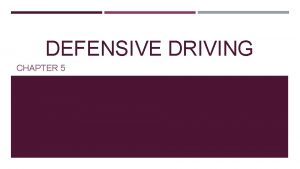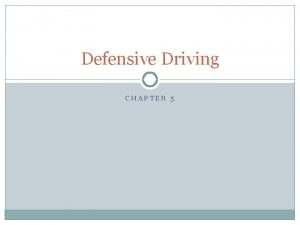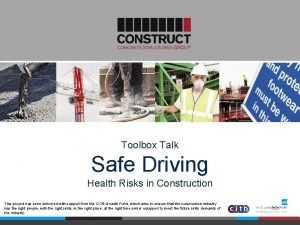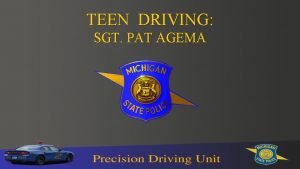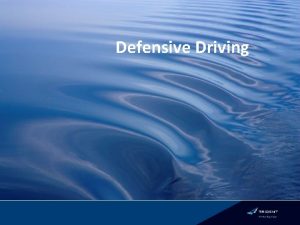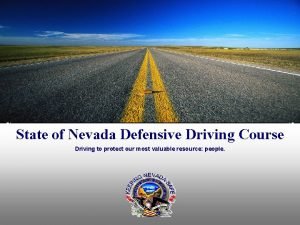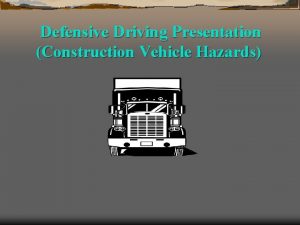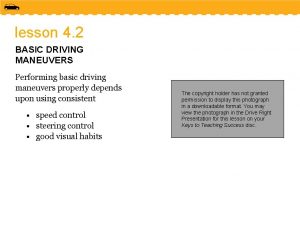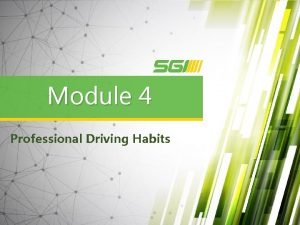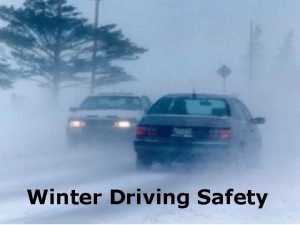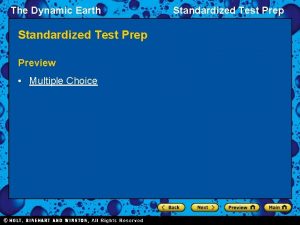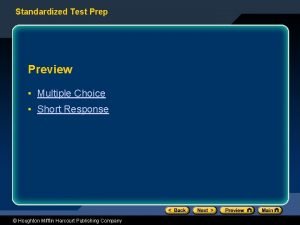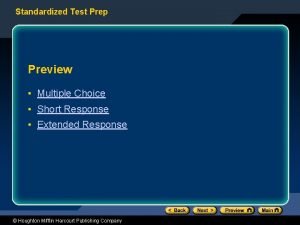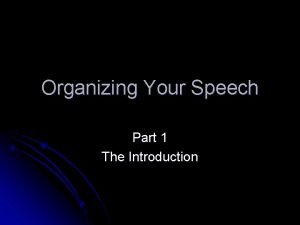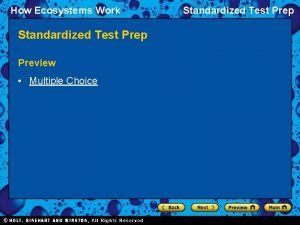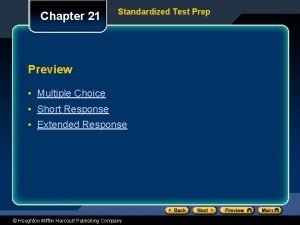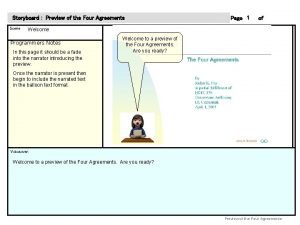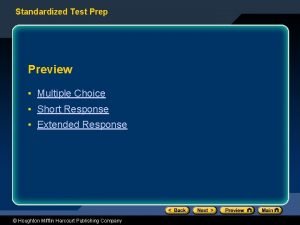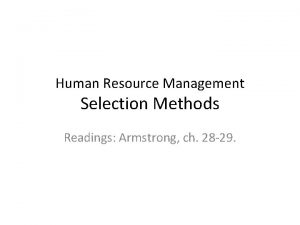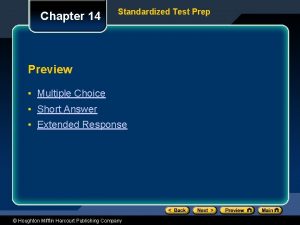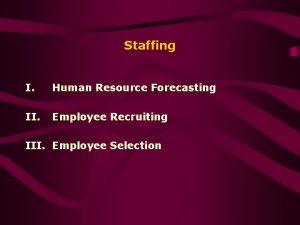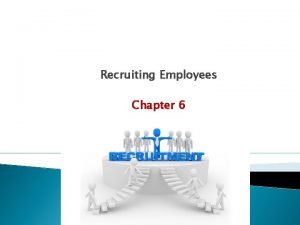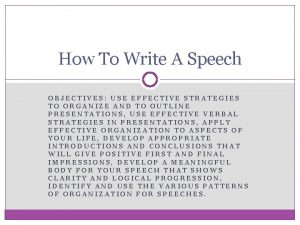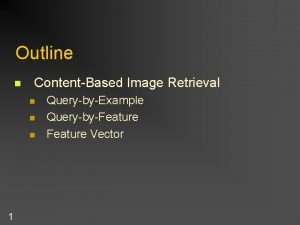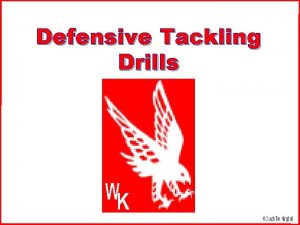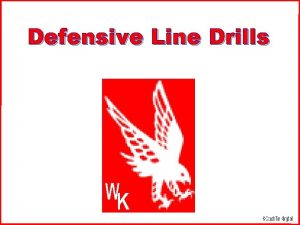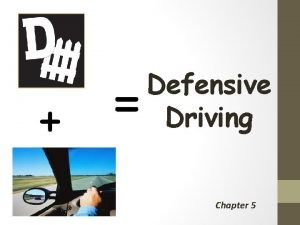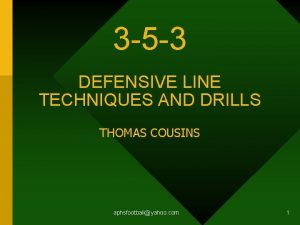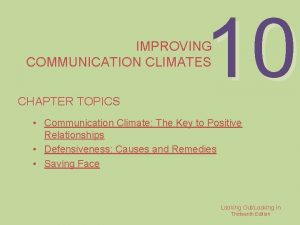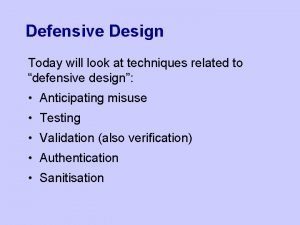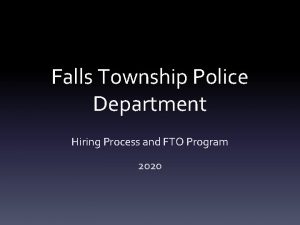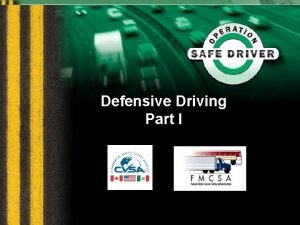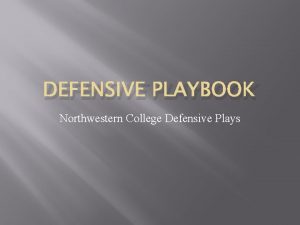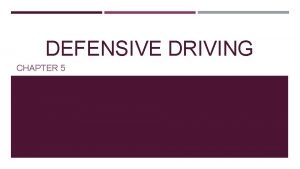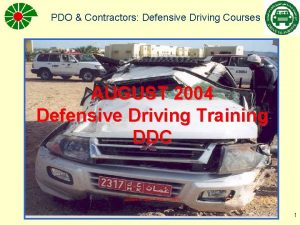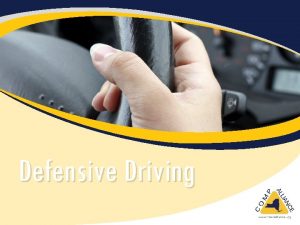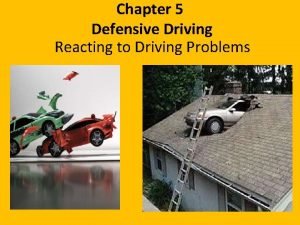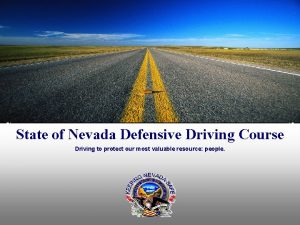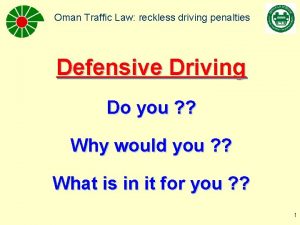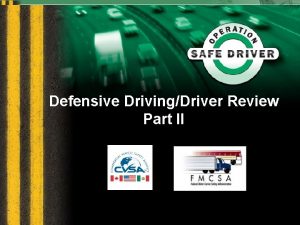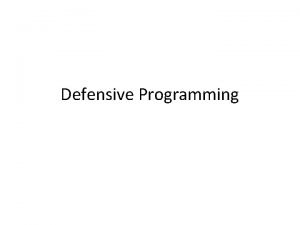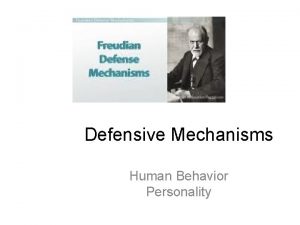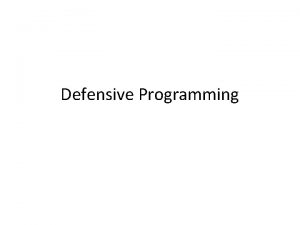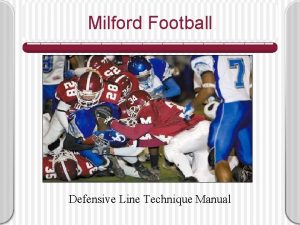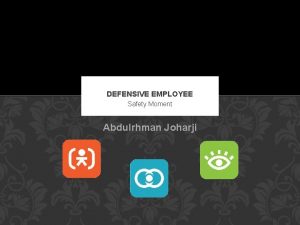DEFENSIVE DRIVING CHAPTER 5 PREVIEW CHAPTER 5 TOPICS


























































- Slides: 58

DEFENSIVE DRIVING CHAPTER 5

PREVIEW CHAPTER 5 TOPICS You will be able to identify defensive driving information. 1. Road rage & driving distractions 2. Safe distance & following distance 3. Road conditions 4. Driving situations 5. Reacting to driving problems 6. Vehicle failure

OBJ: IDENTIFY AGGRESSIVE DRIVING BEHAVIORS AND DEMONSTRATE HOW YOU WOULD REACT TO AGGRESSIVE DRIVING Do now • What actions could lead to road rage?

ANSWER • Extreme cases of aggressive driving leads to road rage

PREVENT A COLLISION Accident prevention formula 1. Be alert 2. Be prepared 3. Act in time

AGGRESSIVE DRIVING • Progression of unlawful driving actions including • Altering the speed of a vehicle • making improper lane changes • disregarding traffic control devices • failing to yield the right of way • tailgating. Extreme cases of aggressive driving leads to road rage

ROAD RAGE Road rage- motorists lose their tempers or become frustrated because of a traffic disturbance • more likely to cause a collision Examples: run stop signs & red lights, speed, tailgate, weave through traffic, pass illegally, improper/unsafe lane changes, make hand or face gestures, scream, honk horns, flash high beams, *cause collision *Have you ever experiences someone with road rage? • Christmas Vacation

AAA

HOW TO HANDLE ROAD RAGE • Do not react to insults, gestures, or other rude behavior. • Do not respond in any way, either verbally or behaviorally, other than to back off and give the aggressive driver room to "leave. " • Stay away from drivers who are speeding or exhibiting another form of anxiety. • Do not engage the aggressive driver—do not establish eye contact. • Do not try to gain the upper hand never try to teach someone a "lesson. "

ACTIVITY • Get into groups of 5 • Discuss and write a situation that can result in a driver becoming aggressive/angry based off of the examples we discussed. Show different degrees of anger by two or more drivers. • Act out in front of class. • The rest of the class will discuss how they could respond in that situation.

SUMMARIZER • In extreme cases, an aggressive driver might do what?

ANSWER • Cause an accident

DRIVE RIGHT • Get with learning partner #7 • Read pages 106 -111 in Drive Right • Answer questions #1 -5 on page 111

OBJ: IDENTIFY DRIVING DISTRACTIONS Do now • What are some things that could lead to distracted driving?

ANSWER • Adjusting the radio • Using a cellular phone or any other electronic device • Eating

COMPLETE THE DISTRACTED DRIVING SAFETY QUIZ • Take out a blank piece of paper and a pen • Write down your answers in order for the questions • DISTRACTED DRIVING SLIDE-page 4 “I will be at your house after I am finished with work tonight. My boss kept me late. Sorry. I’m leaving now”

DISRACTION ACTIVITY 1. Take out your cell phone 2. Watch the following 30 sec. commercial: M & M's 3. You will text/i. Message the following message into your phone/while watching: “I will be at your house after I am finished with work tonight” “My boss kept me late. Sorry. I’m leaving now”

COMMERCIAL QUESTIONS ANSWER ON YOUR NOTE SHEET 1. What did the mom find in the wash? 2. What color was it? 3. What were the two kids eating? 4. What color M & M was sitting on the island? 5. What color is the mom’s laundry basket? 6. What color towel was the “naked” M & M wearing?

M&M COMMERCIAL ANSWERS 1. Red stained clothes 2. Red 3. M & M’s 4. Yellow 5. White 6. White red stripes

DISTRACTIONS *In many cases, collisions are caused by a distracted motorist • Lighting a cigarette • Fasten seatbelt • Reaching to grab something • Getting $ for tolls • Watching children or pets in vehicle • Reading • Eating • Adjusting mirror • Cell phones • Adjusting radio • Applying makeup • Shaving Robbinsville

DISTRACTIONS Discuss with elbow partner 1. Have you ever seen a distracted driver on the road? 2. Have you ever been in the car with a distracted driver? • Cell phone/electronics? • Talking? • Children/pets in vehicle? • Reaching to grab something?

DISTRACTIONS VIDEOS • Boy singing • Don't Text and Drive - Facebook • Texting PSA graphic • ATT - It Can Wait *Texting while driving is involved in 200, 000+ vehicle crashes each year, often causing injuries and deaths. * • State Farm • Steer Clear • Pt. 2 • Steer Clear

OBJ: IDENTIFY ROADWAY CONDITIONS AND DRIVING SITUATIONS Do now • When are road surfaces the MOST slippery?

ANSWER • The first few minutes of a rainfall • Why? • Moisture mixes with oil and dust that hasn’t been washed away

HIGHWAY HYPNOSIS Highway hypnosis • Trance like state that may be avoided by not looking at any one thing for more than a few seconds • How to avoid it? • Not looking at any one object • Can not drive well and reaction time is reduced • A tired driver can be as dangerous as a drunk driver • *Maggie's Law* – 2003 illegal to knowingly drive a vehicle while impaired by lack of sleep

HIGHWAY HYPNOSIS Drowsy driving – who is at risk? • Sleep deprived • Driving long distances • Driving through the night • Taking medicine • Driving alone • Driving long rural roads • Shift workers • Commercial drivers

COMMUNICATING Communicate with motorists by all available means and signals. Always stay in the lane that shows where you intend to turn. • Turn signals • Hand signals • Eye contact • Horn • Flip head lights quickly

SAFE DISTANCE • One Car Length Method- For every 10 mph you are traveling, leave one car length between you and the car you are following (Ex. 5 car lengths if traveling at 50 mph • Three Second Rule- Keep 3 seconds of distance between you and the car you are following. 1. Pick a fixed object ahead of you. 2. When the car in front of you passes that object—begin counting. 3. If it takes at least 3 seconds for you to reach that object you are at a safe following distance.

FOLLOWING DISTANCE Road Condition 20 mph 30 mph 40 mph 50 mph Ideal 2 car lengths 3 4 5 Wet Gravel Packet snow Ice 4 car lengths 6 car lengths 12 car lengths 6 6 9 18 8 8 12 10 10

ROAD CONDITIONS WET ROADS • Drive more slowly • Road surfaces are the MOST slippery the first few minutes of a rainfall • When driving through puddles expect your car to pull in the direction the puddle is on. Pump your brakes after driving through one to dry them out. • After driving through a puddle test your brakes

ROAD CONDITIONS HYDROPLANING When your tires ride on a film of water and lose contact with the road surface. • Begins to occur at 35 mph • Between 35 and 55 mph the tires begin to lose contact. • At reaching 55+ mph tires lose all contact with the road. • In a heavy rainstorm, try to drive on the highest point of the road • hydroplaning

ROAD CONDITIONS SNOW AND ICE Potential dangers include longer night hours, fog, rain, snow, sleet and ice. Necessary precautions include: a) Allowing a proper warm up. b) Remove all ice and snow from your car (you may be liable if ice falls off of your car and causes either and injury or property damage). c) Get the feel of the road- start slow d) Snow tires (studded tires legal from (Nov. 15 th – April 1 st). e) When starting to move keep engine speed slow- spinning wheels will cause you to skid. ABS- keep foot on brake pedal and don’t pump brakes Conventional- firm, steady pressure on the brake pedal.

OTHER ROAD CONDITIONS REDUCED VISIBILITY 1. Frost/Ice- scrape, wipe all windows, turn on defroster 2. Fog- use low beams; use pavement markings and other vehicle lights as guides. 3. Sun Glare- adjust sun visors or wear sun glasses; slow down NO Matter What the REASON- STOP If you cannot see!!

OTHER ROAD CONDITIONS NIGHT DRIVING 90 % of driving decisions are based on what a motorist sees while driving. At night, a motorists vision is reduced. To drive safely at night… • Slow down and drive within the range of the vehicles headlights (if you need to suddenly break, you have enough time to do so) • Don’t over drive your headlights (350 for low beams/500 for high beams). • Be sure you can stop – within the distance you can see ahead

DRIVING SITUATIONS CITY DRIVING More traffic and distractions; try to look at least 12 sec. ahead (about 1 city block). Drive more slowly and be careful for pedestrians HIGHWAY DRIVING Faster speeds/less time to react; easier to lose focus (including highway hypnosis) SECONDARY ROAD DRIVING- hills, bridges, hazards Usually only 2 lanes; sharper turns and hills; limited sight; animals.

DRIVING SITUATIONS RESIDENTIAL More children/pedestrians are present; delivery vehicles. CONSTRUCTION Lane changes; slow moving vehicles; detours, temporary traffic devices including flagmen. **fines doubled**

SUMMARIZER • To maintain the proper following distance when driving, you should remain how far behind the vehicle in front of you?

ANSWER • At least 3 seconds

ACTIVITY • Complete Road Rage raps

OBJ: IDENTIFY COLLISIONS AND REACTING TO DRIVING PROBLEMS Do now: Your car has gone into a skid. What do you do?

ANSWER • Take foot off gas • turn the wheel in the direction the rear of the car is going (into the skid)

REACTING TO DRIVING PROBLEMS IGNITION SYSTEM A motorist in an emergency situation many attempt to turn off the vehicle while it’s still in motion. • Never turn the ignition to lock position while the vehicle is in motion. • The steering will lock and the motorist will lose control of the vehicle. • Permits key removal only when in park

REACTING TO DRIVING PROBLEMS SKIDS CAUSES? • Sudden turns / lane changes • Hard braking • More common on wet and/or icy roads • HOW DO YOU HANDLE IT? • Foot off of accelerator • Steer in direction rear end is heading (into the skid) • Look in the direction you want to go *If the rear end of the vehicle starts to slide, take your foot off the gas pedal *A vehicle may spin if the steering wheel is quickly turned away from the direction of the skid

REACTING TO DRIVING PROBLEMS EMERGENCY STOPS KEEP SEVERAL BASIC POINTS IN MIND • Pull over as far as you can • Make yourself and car as visible as possible • PULLING OVER • Paved shoulder: Allows you to pull over at or near traffic speed • Unpaved shoulder: Slow to a safe speed before pulling over!

REACTING TO DRIVING PROBLEMS EMERGENCY STOPS VISIBILITY! • Turn on lights/emergency flashers • Raise hood • Flares/warning instruments • Tie a white cloth to the antenna or left door handle as a signal, if help is needed MAKE YOURSELF AS VISIBLE AS POSSIBLE!

REACTING TO DRIVING PROBLEMS RUNNING OFF THE PAVEMENT If a vehicles wheel’s drift onto the shoulder of the road, do not try to turn back onto the pavement right away. This could throw the vehicle off balance. • Stay on shoulder • Gradually slow down • At 25 MPH or less, steer ¼ turn towards roadway

REACTING TO DRIVING PROBLEMS CAR FIRES Most caused by short circuits in the electrical system – never try to put out • Get out • Get away • Call for help

REACTING TO DRIVING PROBLEMS • • PLUNGING INTO WATER Vehicles will float 3 -10 minutes Open windows immediately (escape while vehicle is still floating through open window) Sinks nose (front end) first Always wear a seatbelt! Reduce risk of being knocked out unconscious

VEHICLE FAILURE BRAKE FAILURE Conventional or drum disk • shift to lower gear and pump the brake pedal fast and hard several times (this could build up enough pressure to stop the vehicle) • If that doesn’t work, the parking brake should be used while holding the brake so the wheels lock up and the vehicle will skid.

VEHICLE FAILURE TIRE BLOWOUT • Grip the steering wheel • Keep vehicle straight while gradually slowing down • Remove foot from gas and don’t use the brakes • Vehicle should coast to a stop

VEHICLE FAILURE GAS PEDAL PROBLEMS Keep eyes on the road & shift to neutral Steer the vehicle to a safe area off the roadway Turn engine off and call for help

SUMMARIZER • If you have a flat tire or a blow out, you should?

SUMMARIZER • Hold the wheel firmly • Remove foot from gas pedal • Let vehicle coast to a stop

COLLISIONS AVIODING COLLISIONS If a motorist sees that they are going to hit something, one of three things should be done: • Stop quickly - • (conventional brakes) pump the brakes to gain better control of steering. • (ABS brakes) will adjust automatically to prevent wheel lock up. The motorist can put max pressure without pumping the brakes. • Turn quickly – If a motorist can’t stop in time, turn away and drive off the road. Try not to brake to lessen skid chance. Don’t brake hard if turning onto a shoulder to lessen skid and loss of control. • Speed up- When another motorist is about to hit you from the side or behind, speeding up may be necessary to get out of danger. Slow down once out of danger.

COLLISIONS • • LAST MINUTE CHOICES Turn away from oncoming traffic, even if it means leaving the road Driving off the road, rather than skidding, gives the motorist more control of the vehicle What to hit first? • Hit something moving in the same direction as you • Hit something not moving (tree, parked car, median) • Last option- hit coming straight on at you If collision is unavoidable, try to make a glancing blow • A sideswipe will slow the vehicle

COLLISIONS REAR • Be ready to apply brakes to avoid being pushed into a vehicle ahead • Brace your body and press head against head rest • SIDE • Keep a tight grip on the wheel to prevent being thrown against the side of the vehicle • Be ready to turn fast, so that if the vehicle spins you are ready to control it • HEAD ON • Use arms and hands to protect face if wearing a seat belt and the vehicle has airbags

COLLISIONS If you are in a collision • Stop the vehicle • Remain calm • Assume worst and get help (police, ambulance) • Wait at the scene • Ask for assistance • Report to the MVC within 10 days

ACTIVITY Road Rage Raps Criteria for Success My rap/poem includes… • What aggressive driving is • 5 examples of aggressive driving • What road rage is • Examples of road rage • How you would react to someone with road rage • 3 verses • A chorus (at least twice) • A title • Typed final draft • Participation from each group member in writing and performance (sing, dance, sound, props) • Creativity & enthusiasm
 Chapter 5 defensive driving quiz answers
Chapter 5 defensive driving quiz answers Most accidents are caused by _________ driving error.
Most accidents are caused by _________ driving error. Driving at work toolbox talk
Driving at work toolbox talk Michigan state police teenage defensive driving
Michigan state police teenage defensive driving Follow the four r's (read right reduce and ride) when
Follow the four r's (read right reduce and ride) when Nevada defensive driving course
Nevada defensive driving course Defensive driving training course ppt
Defensive driving training course ppt Turnabout driving definition
Turnabout driving definition What is the ipde defensive driving formula?
What is the ipde defensive driving formula? Garland manufacturing company
Garland manufacturing company Winter driving safety topics
Winter driving safety topics Examples of thesis statements
Examples of thesis statements Thesis statement summary
Thesis statement summary Test prep preview
Test prep preview Test prep preview
Test prep preview Test prep preview
Test prep preview Test prep preview
Test prep preview Sccm technical preview
Sccm technical preview Startling statement introduction examples
Startling statement introduction examples What is a preview statement
What is a preview statement Test prep preview
Test prep preview Nnn preview
Nnn preview The selection preview
The selection preview Test prep preview
Test prep preview The four agreements preview
The four agreements preview Test prep preview
Test prep preview Line between pada perintah column digunakan untuk membuat
Line between pada perintah column digunakan untuk membuat Classic trio' of selection techniques
Classic trio' of selection techniques Test prep preview
Test prep preview What is overview skimming
What is overview skimming 1984 book preview
1984 book preview Yandex.ru video
Yandex.ru video Nút lệnh print preview nằm ở đâu
Nút lệnh print preview nằm ở đâu Tams tracks
Tams tracks Review and preview
Review and preview Benefits of hr forecasting
Benefits of hr forecasting Disadvantages of realistic job preview
Disadvantages of realistic job preview Preview of main points
Preview of main points Preview speech
Preview speech Chapter 7 intercultural communication
Chapter 7 intercultural communication Nnn image preview
Nnn image preview Menu collections pane di windows movie maker berguna untuk
Menu collections pane di windows movie maker berguna untuk Defensive interval ratio
Defensive interval ratio Defensive interval ratio
Defensive interval ratio Open field tackling drill
Open field tackling drill Defensive line techniques
Defensive line techniques To avoid collisions a defensive driver should
To avoid collisions a defensive driver should What is rational detachment
What is rational detachment Offensive line everyday drills
Offensive line everyday drills Gibbs defensive behaviors
Gibbs defensive behaviors What is defensive realism
What is defensive realism Two examples of defensive design
Two examples of defensive design Defensive programming java
Defensive programming java Non defensive learning
Non defensive learning Imitative strategy
Imitative strategy Defensive self esteem
Defensive self esteem Aggression escalation continuum stages
Aggression escalation continuum stages Sikap obstruktif dan contohnya
Sikap obstruktif dan contohnya Police defensive tactics
Police defensive tactics
